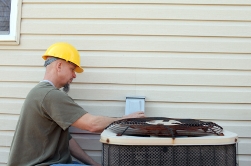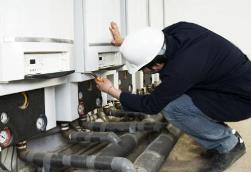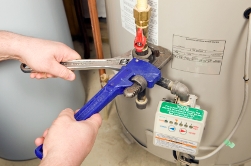How to Enroll In an HVAC Training Course near Sandia Texas
 Once you have made a decision on a career as a heating and air conditioning specialist, the next action is to locate an HVAC trade school near Sandia TX. But with so many to pick from, how do you decide on the right one to get the training that you require? Some potential students will make their decision based solely on the cost of tuition or how near the school is to their residence. Although these are important considerations, they are not the only ones to take into account. Some of the other things that you need to research are the graduation rates of the HVAC schools, their reputations, and if they are accredited by professional trade organizations. These and additional criteria will be discussed in more detail later within this article. But before we tackle how to choose an HVAC trade school, let’s take a look at what a heating and a/c professional does to become a licensed skilled tradesman.
Once you have made a decision on a career as a heating and air conditioning specialist, the next action is to locate an HVAC trade school near Sandia TX. But with so many to pick from, how do you decide on the right one to get the training that you require? Some potential students will make their decision based solely on the cost of tuition or how near the school is to their residence. Although these are important considerations, they are not the only ones to take into account. Some of the other things that you need to research are the graduation rates of the HVAC schools, their reputations, and if they are accredited by professional trade organizations. These and additional criteria will be discussed in more detail later within this article. But before we tackle how to choose an HVAC trade school, let’s take a look at what a heating and a/c professional does to become a licensed skilled tradesman.
[campusexplorer header_text=”Find HVAC Training Schools Near You!” aos=”53237562″ concentration=”16D42C74″ tracking=”HVAC-D”]
Becoming an HVAC Professional in Sandia TX
 HVAC is an acronym that is extensively used in the business that stands for “Heating, Ventilation and Air Conditioning”. HVAC professionals provide services for the installation, repair and maintenance of air conditioners, furnaces, boilers, water heaters and heating systems. As skilled tradesmen, they are generally mandated to be licensed, however each state and local municipality has its own criteria. Attaining professional certification is not compulsory, but an optional means for Sandia TX HVAC techs to establish that they are highly qualified and knowledgeable in their area of specialization. There are multiple acknowledged certifications within the field that are offered. Following are a few of the significant ones.
HVAC is an acronym that is extensively used in the business that stands for “Heating, Ventilation and Air Conditioning”. HVAC professionals provide services for the installation, repair and maintenance of air conditioners, furnaces, boilers, water heaters and heating systems. As skilled tradesmen, they are generally mandated to be licensed, however each state and local municipality has its own criteria. Attaining professional certification is not compulsory, but an optional means for Sandia TX HVAC techs to establish that they are highly qualified and knowledgeable in their area of specialization. There are multiple acknowledged certifications within the field that are offered. Following are a few of the significant ones.
- North American Technician Excellence (NATE). NATE is a nationally acknowledged certification for HVAC techs. The certification is earned by passing a proficiency exam and may be earned in one or more specialties.
- HVAC Excellence. This certification makes available both a professional and a master specialist credential. Two years of field experience as well as passing a comprehensive exam are needed for the professional level certification. Master specialists need to have 3 years of experience as well as a passing score on the professional level examination. As with NATE, certifications are provided in various specialties.
- EPA Section 608. This certification is mandatory for technicians that handle refrigerants. There are three forms of certification available, one for small appliances, and the additional two for low and high pressure refrigerants.
Because licensing could be required in your location, and you may also wish to earn certification, it’s essential that you choose an HVAC vocational school that will prepare you for both. And since you will probably be dealing with refrigerants, make certain that the program you decide on prepares you for passing the EPA Section 608 examinations.
HVAC Certificate and Degree Courses
 There are several choices available for HVAC instruction in a vocational or trade school. You can earn a certificate, an Associate Degree, or a Bachelor’s Degree. Acquiring a certificate will take the minimum amount of time, typically completed in just 6 months, although some programs are longer. A certificate will qualify you for most HVAC positions, particularly if you are licensed and have certification related to the position. The degree training programs might provide a competitive edge in the job market and will provide more in-depth training than the certificate programs. Below is a brief description of each option offered near Sandia TX.
There are several choices available for HVAC instruction in a vocational or trade school. You can earn a certificate, an Associate Degree, or a Bachelor’s Degree. Acquiring a certificate will take the minimum amount of time, typically completed in just 6 months, although some programs are longer. A certificate will qualify you for most HVAC positions, particularly if you are licensed and have certification related to the position. The degree training programs might provide a competitive edge in the job market and will provide more in-depth training than the certificate programs. Below is a brief description of each option offered near Sandia TX.
- Certificate. Usually requiring a high school diploma, certificate programs are very popular among beginning commercial or residential HVAC technicians. They provide a solid foundation of skills for employment within the trade.
- Associate Degree. The Associate Degree in HVAC program delivers a more detailed knowledge of heating & cooling systems than the certificate program. Typically taking two years to finish, many degrees incorporate an internship or work-study program.
- Bachelor’s Degree. The Bachelor’s Degree in HVAC is geared more for a career in management or even business ownership. Some programs call for an Associate Degree, while others are a traditional 4 year program. In addition to mastering how to service and maintain heating and air conditioning systems, you will also learn how to design them.
Choosing the right credential program will be dependent on what your long term career aspirations are, along with the time and financial resources that you have to invest. One approach is to start with a certificate or perhaps an Associate Degree program, and after acquiring some experience in the trade in Sandia TX, later going back to acquire a Bachelor’s Degree. If this is your approach, be sure to ask the HVAC technician school you are looking at about how their returning student program works.
HVAC Schools Online
 Attending an HVAC program online is one approach to obtaining your education and earning a certificate or degree. Most schools will require some attendance on campus to complete hands on training. Some also provide internship or work-study programs in addition to or as an alternative to practical lab work. But since the rest of the classes can be attended online, this alternative may be a more practical solution for many Sandia TX students that are short on time. And a number of online degree programs are cheaper than other on campus options. Even commuting expenses from Sandia and study supplies may be reduced, helping to make schooling more economical. And a large number of online programs are fully accredited (more on this later). So if your work or family commitments have left you with little time to attend classes, perhaps an HVAC online training program will make it more convenient to fit school into your busy schedule.
Attending an HVAC program online is one approach to obtaining your education and earning a certificate or degree. Most schools will require some attendance on campus to complete hands on training. Some also provide internship or work-study programs in addition to or as an alternative to practical lab work. But since the rest of the classes can be attended online, this alternative may be a more practical solution for many Sandia TX students that are short on time. And a number of online degree programs are cheaper than other on campus options. Even commuting expenses from Sandia and study supplies may be reduced, helping to make schooling more economical. And a large number of online programs are fully accredited (more on this later). So if your work or family commitments have left you with little time to attend classes, perhaps an HVAC online training program will make it more convenient to fit school into your busy schedule.
What to Ask HVAC Certification Classes near Sandia TX
As soon as you have selected the type of degree or certificate that you wish to attain, either online or on campus, you can start to decrease your selection of schools. As you are probably aware, there are many HVAC vocational schools in the Sandia TX area and throughout the USA to pick from. That’s why it is essential to have a list of key qualifiers when making school assessments. As previously stated in our opening paragraph, location and tuition will undoubtedly be the initial two aspects you will take into consideration. Following are some additional ones that you need to research before enrolling in your school of choice.
Accreditation. Many HVAC technical schools in the Sandia TX area have earned either a regional or a national accreditation. They may receive Institutional Accreditation, which focuses on the school’s programs as a whole, or Programmatic Accreditation, which relates to an individual program, for example HVAC technology. Make sure that the school is accredited by a U.S. Department of Education acknowledged accrediting organization, for instance the Accreditation Board for Engineering and Technology. In addition to helping make certain that you obtain a quality education, it can help in securing financial aid or student loans, which are frequently not available for non-accredited programs. Additionally, a number of states mandate that the HVAC training program be accredited for it to qualify for licensing.
High Completion Rates. Ask the Heating and Cooling schools you are reviewing what their completion rates are. The completion rate is the percentage of students who enroll in and complete the program. A lower completion rate might signify that students were disappointed with the program and quit. It may also suggest that the teachers were not qualified to train the students. It’s also imperative that the schools have higher job placement rates. Older and/or more reputable schools may have a more extensive directory of graduates, which may result in more contacts for the school to employ for their apprenticeship and job placement programs. A high job placement rate can not only confirm that the school has an excellent reputation within the industry, but additionally that it has the network of Sandia TX HVAC employers to assist graduates obtain apprenticeships or jobs.
Apprenticeship Programs. Many HVAC training programs are taught in conjunction with an apprenticeship or an internship program. Those participating vocational and trade programs will help place you in an apprenticeship program inside their network of HVAC businesses or labor unions. Check if the schools you are considering have working relationships with local Sandia TX HVAC specialists. An apprenticeship not only offers a valuable experience by providing hands-on training, but it also furnishes job opportunities and helps to establish relationships in the local HVAC professional community.
Modern Facilities. Confirm that the campus facilities and the tools that you will be trained on are state-of-the-art and what you will be working with on the job. If you are already in an internship or an apprenticeship, consult with the HVAC tech you are working under concerning what you should be looking for. If not, ask a local Sandia TX HVAC contractor if they can give you some tips. Also keep in mind that unless you are able to relocate, the school needs to be within driving distance of your Sandia TX home. Remember that if you decide to attend an out-of-state school, in addition to relocation costs there can be higher tuition fees compared to in-state residents.
Smaller Classes. It’s important that you get as much personalized training as possible, which can be challenging in bigger classes. Ask if you can monitor some of the classes so that you can see how big they are and experience the interaction between students and instructors. Talk to several of the students and get their feedback concerning class sizes and instruction. Finally, speak with a few of the teachers and find out what their level of expertise is and what degrees or certifications they have earned.
Flexible Scheduling. Verify that the class schedules for the schools you are assessing are flexible enough to fulfill your needs. If you are only able to attend classes in the evening or on weekends near Sandia TX, check that the schools you are considering offer those choices. If you can only attend on a part-time basis, make sure that the school you select offers part-time enrollment. Additionally, ask what the protocol is to make-up classes should you miss any due to work, sickness or family responsibilities.
Attending HVAC School near Sandia TX?
Sandia, Texas
Sandia was in the Casa Blanca land grant, issued to Juan José de la Garza Montemayor by Spain on April 2, 1807. The Montemayor family occupied the land until 1852. In 1896 John L. Wade purchased it and established the Casa Blanca Ranch (Wade Ranch). Upon his death the ranch was divided among his heirs, one of whom sold his share to Joseph B. Dibrell. Dibrell gave the task of dividing and selling the land to Fennell Dibrell and Max Starcke, who founded Sandia in 1907. At the time the streets were platted there was only one building in the community. Dibrell and Starcke chose the name Sandia, Spanish for "watermelon," because of the large number of watermelons grown in the area. The lots in Sandia were all sold within eight months, during which time a lumberyard, a hardware store, two grocery stores, a meat market, a boardinghouse, and a barbershop opened. By 1914 Sandia had 150 inhabitants, a bank, two general stores, and a cotton gin. The population steadily increased and in 1925 was estimated at 200. It had increased to 500 by 1927. In 1936 Sandia had three businesses, two churches, multiple farm units, and several dwellings and was a stop on the Texas and New Orleans Railroad. In 1940 it had a population of 300 and fifteen businesses. Sandia had a peak population of 310 during the 1960s and early 1970s. Residents numbered 215 in 1974 and 1990.
As of the census[1] of 2000, there were 431 people, 139 households, and 106 families residing in the CDP. The population density was 445.3 people per square mile (171.6/km²). There were 158 housing units at an average density of 163.2/sq mi (62.9/km²). The racial makeup of the CDP was 75.87% White, 1.16% African American, 3.25% Native American, 0.93% Asian, 0.23% Pacific Islander, 16.47% from other races, and 2.09% from two or more races. Hispanic or Latino of any race were 61.25% of the population.
There were 139 households out of which 35.3% had children under the age of 18 living with them, 61.2% were married couples living together, 9.4% had a female householder with no husband present, and 23.7% were non-families. 22.3% of all households were made up of individuals and 7.9% had someone living alone who was 65 years of age or older. The average household size was 3.10 and the average family size was 3.63.
Enroll in the Right HVAC Certification Training near Sandia TX
Enrolling in the right HVAC training course is an important beginning toward a rewarding career in the heating and cooling industry. As we have addressed in this article, you need to pick a school and a degree or certificate program that are both accredited and have exceptional reputations within the HVAC field. Other factors to look for are plenty of practical training and state-of-the-art facilities. You need to go to each of the schools in person that you are most interested in to explore the campus and talk with both the current students and faculty. Attempt to get a feel for the quality of the instruction and the interaction between them. In addition, inquire about scheduling choices and if night or weekend classes are available if needed. And don’t forget to inquire about financial assistance and student loan options too. If you ask the proper questions as we have detailed in our checklist for comparing schools, you’ll be able to narrow down your choices so that you can make an informed decision. With the proper training, hard work and dedication, you can eventually become a licensed HVAC professional in Sandia TX.
More Fabulous Cities in Texas
Business Results 1 - 10 of 18










